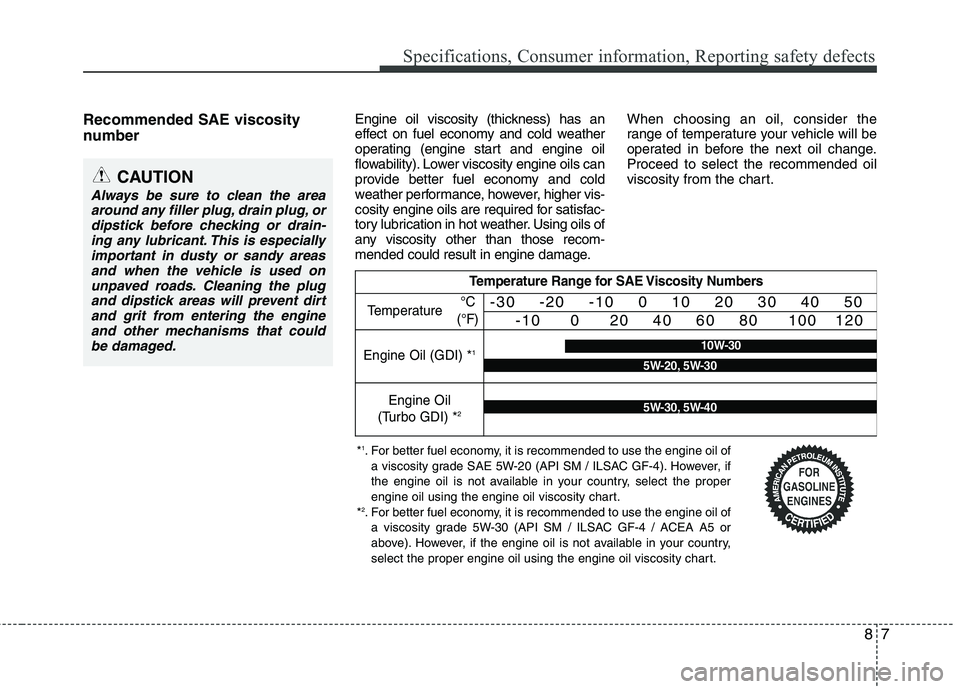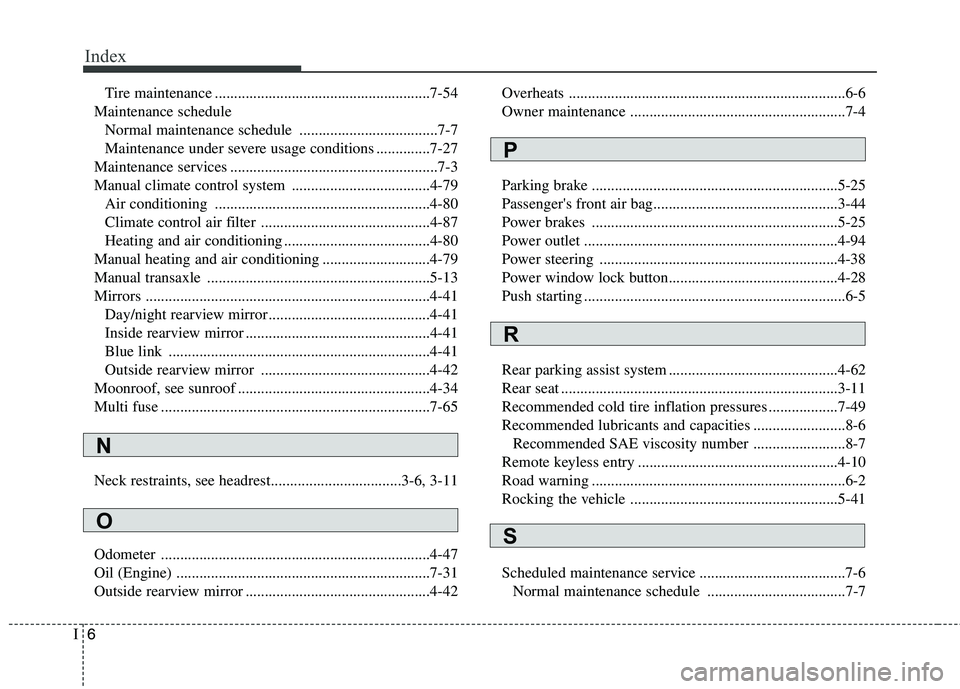2013 HYUNDAI VELOSTER oil viscosity
[x] Cancel search: oil viscosityPage 228 of 372

547
Driving your vehicle
Use high quality ethylene glycol
coolant
Your vehicle is delivered with high quality
ethylene glycol coolant in the cooling
system. It is the only type of coolant that
should be used because it helps prevent
corrosion in the cooling system, lubri-
cates the water pump and prevents
freezing. Be sure to replace or replenish
your coolant in accordance with the
maintenance schedule in section 7.
Before winter, have your coolant tested to
assure that its freezing point is sufficient
for the temperatures anticipated during
the winter.
Check battery and cables
Winter puts additional burdens on the
battery system. Visually inspect the bat-
tery and cables as described in section
7. The level of charge in your battery can
be checked by an authorized HYUNDAI
dealer or a service station.
Change to "winter weight" oil if
necessary
In some climates it is recommended that
a lower viscosity "winter weight" oil be
used during cold weather. See section 8
for recommendations. If you aren't sure
what weight oil you should use, consult
an authorized HYUNDAI dealer.
Check spark plugs and ignition
system
Inspect your spark plugs as described in
section 7 and replace them if necessary.
Also check all ignition wiring and compo-
nents to be sure they are not cracked,
worn or damaged in any way.
WARNING- Tire chains
The use of chains may adversely
affect vehicle handling.
Do not exceed 20 mph (30 km/h)
or the chain manufacturer’s rec-
ommended speed limit, whichev-
er is lower.
Drive carefully and avoid bumps,
holes, sharp turns, and other
road hazards, which may cause
the vehicle to bounce.
Avoid sharp turns or locked-
wheel braking.
CAUTION
Chains that are the wrong size or
improperly installed can damage
your vehicle's brake lines, sus-
pension, body and wheels.
Stop driving and retighten the
chains any time you hear them
hitting the vehicle.
Page 359 of 372

Specifications, Consumer information, Reporting safety defects
6 8
*1Refer to the recommended SAE viscosity numbers on the next page.
*2Engine oils labeled Energy Conserving Oil are now available. Along with other additional benefits, they contribute to fuel econ-
omy by reducing the amount of fuel necessary to overcome engine friction. Often, these improvements are difficult to measure
in everyday driving, but in a year’s time, they can offer significant cost and energy savings.
*
3If the API service SM engine oil is not available in your country, you may substitute API service SL.
LubricantVolumeClassification
Coolant
Automatic transaxle5.5 US qt. (5.2 l)Mixture of antifreeze and water
(Ethylene glycol base coolant for aluminum radiator)Manual Transaxle5.28 US qt. (5.0 l)Ecoshift dual clutch transmission
Brake/clutch fluid0.7~0.8 US qt.
(0.7~0.8 l)FMVSS116 DOT-3 or DOT-4
Fuel13.2 US gal. (50 l)Unleaded gasoline
Page 360 of 372

87
Specifications, Consumer information, Reporting safety defects
Recommended SAE viscosity
numberEngine oil viscosity (thickness) has an
effect on fuel economy and cold weather
operating (engine start and engine oil
flowability). Lower viscosity engine oils can
provide better fuel economy and cold
weather performance, however, higher vis-
cosity engine oils are required for satisfac-
tory lubrication in hot weather. Using oils of
any viscosity other than those recom-
mended could result in engine damage.When choosing an oil, consider the
range of temperature your vehicle will be
operated in before the next oil change.
Proceed to select the recommended oil
viscosity from the chart.
CAUTION
Always be sure to clean the area
around any filler plug, drain plug, or
dipstick before checking or drain-
ing any lubricant. This is especially
important in dusty or sandy areas
and when the vehicle is used on
unpaved roads. Cleaning the plug
and dipstick areas will prevent dirt
and grit from entering the engine
and other mechanisms that could
be damaged.
*1. For better fuel economy, it is recommended to use the engine oil of
a viscosity grade SAE 5W-20 (API SM / ILSAC GF-4). However, if
the engine oil is not available in your country, select the proper
engine oil using the engine oil viscosity chart.
*
2. For better fuel economy, it is recommended to use the engine oil of
a viscosity grade 5W-30 (API SM / ILSAC GF-4 / ACEA A5 or
above). However, if the engine oil is not available in your country,
select the proper engine oil using the engine oil viscosity chart.
Temperature Range for SAE Viscosity Numbers
Temperature -30 -20 -10 0 10 20 30 40 50
-10 0 20 40 60 80 100 120
Engine Oil (GDI) *1
Engine Oil
(Turbo GDI) *2
10W-30
5W-20, 5W-30
5W-30, 5W-40
°C
(°F)
Page 370 of 372

Index
6I
Tire maintenance ........................................................7-54
Maintenance schedule
Normal maintenance schedule ....................................7-7
Maintenance under severe usage conditions ..............7-27
Maintenance services ......................................................7-3
Manual climate control system ....................................4-79
Air conditioning ........................................................4-80
Climate control air filter ............................................4-87
Heating and air conditioning ......................................4-80
Manual heating and air conditioning ............................4-79
Manual transaxle ..........................................................5-13
Mirrors ..........................................................................4-41
Day/night rearview mirror ..........................................4-41
Inside rearview mirror ................................................4-41
Blue link ....................................................................4-41
Outside rearview mirror ............................................4-42
Moonroof, see sunroof ..................................................4-34
Multi fuse ......................................................................7-65
Neck restraints, see headrest..................................3-6, 3-11
Odometer ......................................................................4-47
Oil (Engine) ..................................................................7-31
Outside rearview mirror ................................................4-42Overheats ........................................................................6-6
Owner maintenance ........................................................7-4
Parking brake ................................................................5-25
Passenger's front air bag................................................3-44
Power brakes ................................................................5-25
Power outlet ..................................................................4-94
Power steering ..............................................................4-38
Power window lock button............................................4-28
Push starting ....................................................................6-5
Rear parking assist system ............................................4-62
Rear seat ........................................................................3-11
Recommended cold tire inflation pressures ..................7-49
Recommended lubricants and capacities ........................8-6
Recommended SAE viscosity number ........................8-7
Remote keyless entry ....................................................4-10
Road warning ..................................................................6-2
Rocking the vehicle ......................................................5-41
Scheduled maintenance service ......................................7-6
Normal maintenance schedule ....................................7-7
O
P
N
R
S